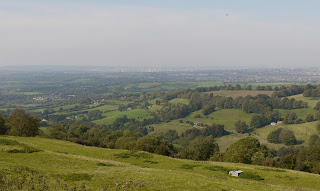St John's church, Mortimer
In May I did a Mystery Walk for the Ramblers around Beech Hill. This is part of a project in which members are asked to walk two miles of path in a given grid square and then rate the walk along a number of dimensions. The resulting data enables an overall assessment of the performance of local authorities. The first report is available on the Ramblers website and the headline message is quite encouraging. I naturally volunteered to do another and was assigned grid square SU6565, just north of Mortimer.
I started by walk in the car park in front of St John's church in Mortimer and headed north along teh side of the recreation ground, and then through woodland (which marked the start of the Mystery element) to reach Bridge's Farm.
After a short stretch of road, I continued northwards through Starvale Woods, already beginning to look autumnal as the bracken dies down.
This gives way to the quite similar Wokefield Common (in fact more woodland). At the edge of Burghfield Common, I turned back at an acute angle to emerge from the woods and walk along Lockram Rd.
Here I turned right and headed south across a series of ploughed fields in welcome open country, with a few gentle hills to provide variety.
Wokefield Park, an extensively modernised Georgian house, now a conference centre, provided a view to the east. At Wheat's Farm I turned west, back to the start.
I gave it the highest possible Mystery Walking ratings, as the signposting, waymarking and condition of the paths were all exemplary. Well done West Berkshire Council!
Conditions: cloudy, mild, 18 ish.
Distance: just over 4 miles.
Map: Explorer 159 (Reading and Pangbourne).
Rating: three stars.
Reflections
I was quite pleased with the ease with which I designed the route and then followed it in the map. My skills in these areas must finally be improving. I have had some practice on the South West Coast Path, although it must be acknowledged that the presence of the sea makes the whole thing so much easier.
Flower of the day
Not many flowers about of course, but this, I think, Oxeye Daisy caught my eye. I have sometimes had trouble getting a good photo of mainly white flowers, but this one came out quite well.










